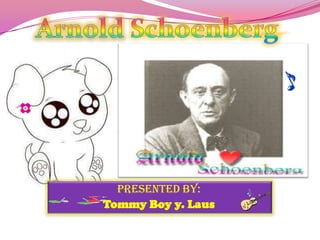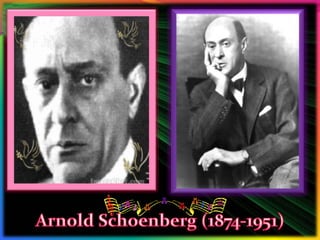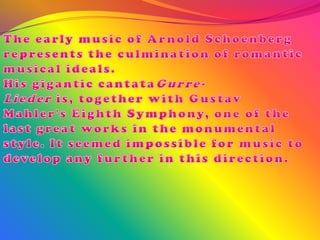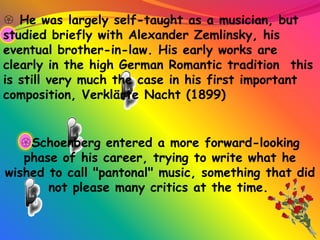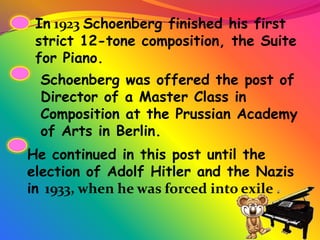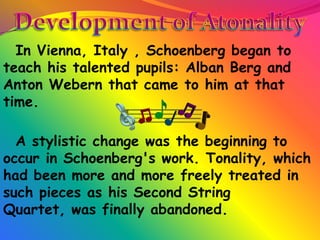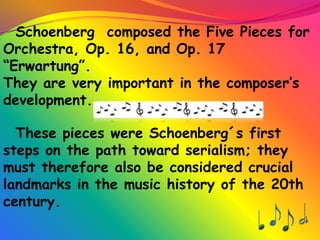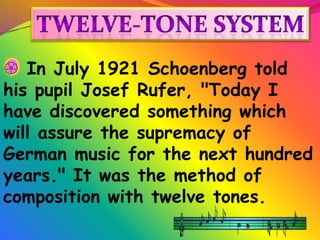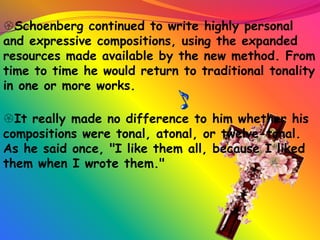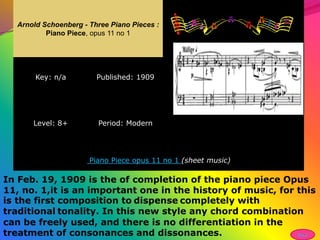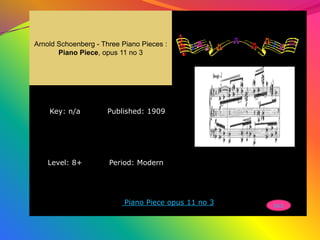20th century music arnold shoenberg
- 1. Presented by: Tommy Boy y. Laus
- 5. ’ü╗ He was acknowledged as one of the most significant figures in modern music history ’ü╗ He was an Austrian composer who was the most controversial creator of the twelve tones composition technique radically transformed 20th- century music, seems to have had a great fear of the number thirteen. Legend states that he had predicted the date of his own death, which occurred on Friday the 13th July 1951 at the age of 76
- 6. ’ü╗ He was largely self-taught as a musician, but studied briefly with Alexander Zemlinsky, his eventual brother-in-law. His early works are clearly in the high German Romantic tradition this is still very much the case in his first important composition, Verkl├żrte Nacht (1899) ’ü╗Schoenberg entered a more forward-looking phase of his career, trying to write what he wished to call "pantonal" music, something that did not please many critics at the time.
- 7. In 1923 Schoenberg finished his first strict 12-tone composition, the Suite for Piano. Schoenberg was offered the post of Director of a Master Class in Composition at the Prussian Academy of Arts in Berlin. He continued in this post until the election of Adolf Hitler and the Nazis in 1933, when he was forced into exile .
- 8. The composer spent most of the remainder of his life in the U.S. Despite much critical resistance, Schoenberg always stuck to his ideas, insisting that the death of tonality was an inevitable step in the evolution of music. He was a brilliant teacher, partly through his method of engaging with the methods of the great classical composers, partly through his focus on bringing out the musical and compositional individuality of his students. He published a number of books, for example the famous Harmonielehre (Theory of Harmony, 1911).
- 9. In Vienna, Italy , Schoenberg began to teach his talented pupils: Alban Berg and Anton Webern that came to him at that time. A stylistic change was the beginning to occur in Schoenberg's work. Tonality, which had been more and more freely treated in such pieces as his Second String Quartet, was finally abandoned.
- 10. Schoenberg composed the Five Pieces for Orchestra, Op. 16, and Op. 17 ŌĆ£ErwartungŌĆØ. They are very important in the composerŌĆÖs development. These pieces were Schoenberg┬┤s first steps on the path toward serialism; they must therefore also be considered crucial landmarks in the music history of the 20th century.
- 11. ’ü╗ In July 1921 Schoenberg told his pupil Josef Rufer, "Today I have discovered something which will assure the supremacy of German music for the next hundred years." It was the method of composition with twelve tones.
- 12. ’ü╗In the twelve-tone method each composition is based on a row, or series, using all twelve notes of the chromatic scale in an order chosen by the composer. ’ü╗ The Prelude of Schoenberg's Piano Suite, Opus 25 is probably the first twelve-tone composition.
- 13. ’ü╗All harmonies and melodies in a composition are derived from its special row; thus, unity is assured. While some critics feared that music written in this way might become mechanical and inexpressive. ’ü╗Besides being presented in its original form, the row may be inverted, played backward, played backward in inversion, or transposed to any scale step.
- 14. ’ü╗Schoenberg continued to write highly personal and expressive compositions, using the expanded resources made available by the new method. From time to time he would return to traditional tonality in one or more works. ’ü╗It really made no difference to him whether his compositions were tonal, atonal, or twelve-tonal. As he said once, "I like them all, because I liked them when I wrote them."
- 15. Notable works: Verkl├żrte Nacht, Op.4 (1899) (string sextet) Pierrot Lunaire, Op. 21 (1912) ("melodrama" for narrator and five musicians) Violin Concerto, Op. 36 (1935-1936) Piano Concerto, Op.42 (1942) A Survivor from Warsaw, Op.46 (1947) Fantasy for Violin and Piano Op. 47 (1949)
- 16. The Three Piano Pieces of Op. 11 were written in a very productive creative phase in 1909. Title Key Published Type Level Piano Piece - n/a 1909 Piece 8+ op 11 no 1 Piano Piece - n/a 1909 Piece 8+ op 11 no 2 Piano Piece - n/a 1909 Piece 8+ op 11 no 3
- 17. The date of completion of the piano piece Opus 11, no. 1 (Feb. 19, 1909), is an important one in Arnold Schoenberg - Three Piano Pieces : the history of music, for this is the first composition to dispense completely with Piano Piece, opus 11 no 1 traditional tonality. In this new style any chord combination can be freely used, and there is no differentiation in the treatment of consonances and dissonances. The date of completion of the piano Key: n/a Published: 1909 piece Opus 11, no. 1 (Feb. 19, 1909), is an important one in the history of music, for this is the first composition to dispense completely with traditional tonality. In this new style any chord combination can be freely used, and there is no differentiation Level: 8+ Period: Modern in the treatment of consonances and dissonances. Piano Piece opus 11 no 1 (sheet music) In Feb. 19, 1909 is the of completion of the piano piece Opus 11, no. 1,it is an important one in the history of music, for this is the first composition to dispense completely with traditional tonality. In this new style any chord combination can be freely used, and there is no differentiation in the treatment of consonances and dissonances. BACK
- 18. Arnold Schoenberg - Three Piano Pieces : Piano Piece, opus 11 no 2 Key: n/a Published: 1909 Level: 8+ Period: Modern BACK Piano Piece opus 11 no 2
- 19. Arnold Schoenberg - Three Piano Pieces : Piano Piece, opus 11 no 3 Key: n/a Published: 1909 Level: 8+ Period: Modern Piano Piece opus 11 no 3 BACK

